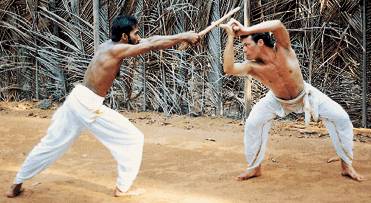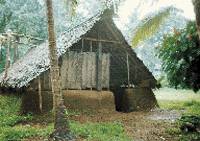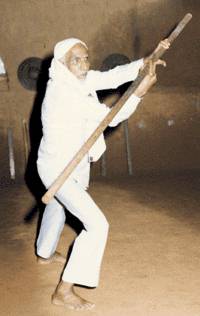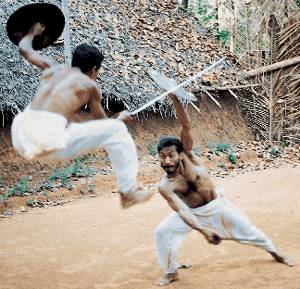Positive Health Online
Your Country

Kalarippayat: The Martial Art of Kerala, South India
by John Paul Cassie(more info)
listed in chi energy martial arts, originally published in issue 35 - December 1998
Kalarippayat, the ancient martial art of South India, is based on the science of Yoga for its forms and exercises, and its medical treatments are based on the science of Ayurveda.
In Malayalam (the dialect of Kerala), Kalarippayat means 'the fighting art of the Kalari'. In ancient South India the Kalari was a college or place of learning for subjects such as medicine, philosophy, astrology, architecture and geometry in addition to combat arts and Yoga. Another definition is Kalari (battlefield), and Payat (training in the art of combat).

Short Stick Practice (the author is pictured on the right)
The origins of Kalarippayat are obscured by time, since it has been nurtured from the oldest martial traditions of Dravidian South India, with later influences from North Indian Aryan martial traditions, which are linked with Dhanur Veda – the science of the Art of War of ancient India. It is possible that Kalari in its present form has existed, with little change, for over 1500 years, according to the Traditions of the Masters.
Kalari as it is known today is a fusion of North and South Indian fighting traditions, embracing the martial and spiritual practices of Hinduism, Buddhism and Islamic Sufism
The Kalari and its construction

The Kalari – the original place of training for Kalarippayat
There were in existence five different types of Kalaries for different purposes: Kurum Kalari, for guerrilla-training; Anka-Kalari for duels; Cheru-Kalari for treatment; Kodum-Kalari for meditation and for teaching the science of Marma (Vital Points); and Kuzhi-Kalari for the everyday training of practitioners. This last type is the form of Kalari which is still existing in Kerala today for the practice of Kalarippayat.
The Kalari is constructed 42 feet east to west and 21 feet north to south. The measurement is the foot-span of the Gurukkal (master) of the Kalari. The ground is dug 3 ft deep with a 3 ft wall built up all around. A thatched roof of bamboo and coconut leaves blends in with the natural surroundings, and is in harmony with the climatic conditions of the place. The floor is disinfected with herbs, oils and natural pigments so that no skin problems arise due to the bare bodied training done in the Kalari – only a loin cloth (Langutti) is worn by men, women wear loose tunic and trousers. The floor of the Kalari is made slippery with a special oil from the leaves of a tree known locally as Kulir Mavu. The slippery conditions create very strong footwork as well as naturally teaching the practitioner to use abdominal strength involuntarily.
The entrance to the Kalari is in the middle of the eastern wall, with three steps leading down inside. In the south-west corner of the Kalari is constructed a seven tiered platform in a conical shape known as Poothara, which symbolises the subtle and gross concepts of the universe and the human being in general. A flower or a lighted lamp placed on the topmost platform serves as a focus for eye exercises and concentration training known as 'Trataka' in yoga. Next to the Poothara, on the right, are two more smaller platforms symbolising the seat of the Past Masters (Guru-Thara) and the seat of Lord Ganesh, (Ganapathi-Thara) the 'Lord of Obstruction' or the lord who helps clear the negative thinking of the mind.

Long Stick Form by one of the Old Masters of Central Style Kalari
All the weapons are kept on a stand on the western side of the Kalari. The Master stands on the western side while giving instruction to the students, who begin their exercises from the eastern side. The exercises are generally not practised in a north-south direction, since according to Yoga and Ayurveda, the magnetic field of the South Pole is injurious to health when facing it directly for prolonged practice.

Northern Kalari Sword and Shield fighting form, showing one of
the spectacular leaps for which Northern Style is famous
Northern Style Kalari (Vadakkan Kalari)
There are three main styles of Kalari: Northern, Central and Southern, found within those particular regions of Kerala.
Training in Northern Kalari begins with the practitioner putting medicinal oil all over the body; the oil is health-promoting, and helps to improve flexibility and stamina. The exercises begin with the Lamp salutation (Poothara Wandanam) carried out in a low crouching 'Cat stance' in front of the seven tiered platform (Poothara). The hands move in a circular motion in front of the body, synchronised with breathing. The fixing of the eyes on a particular point of the Poothara improves concentration and single point focus (Ekagrata).
The lamp Salutation leads onto the Kalari Salutation (Kalari Wandanam) which combines five different Yoga postures in a moving form, with complete body and mind co-ordination. The movements are synchronised with natural breathing, emphasising concentration through single pointed focus which carries over into a meditative state. The symbolic representation of attack and defence relates to the fight of the inner self against the negative aspect of the mind, which is specifically a hindrance in a life or death situation. The negative aspect appears in the form of attachment to worldly desires and most importantly the fear of death. Therefore, the Kalari Salutation practised before a battle would prepare a warrior to face death with detachment, or in essence to be liberated from the fear of death. This is also most applicable in our modern age, in the fight for survival in daily life, in today's hectic market-place world.
The training then moves onto the more vigorous Leg Exercises (Kaal Ettuppu), which are twelve in number from basic to advanced. Kalari students are taught to raise their legs with the least effort and to touch the palms of their hands, which are raised above the head, with their feet. The Leg Exercises naturally induce a form of breathing, as the legs go up and come down, which according to ancient knowledge instils in the body the breathing mechanism to adjust, according to the situation, for fighting. Other benefits include a high level of stamina, flexibility and an overall improvement in fitness and health.
Northern Kalari practice then moves onto the Shiva and Shakti forms. The Shiva forms (Shiva Swaroopa) are hard, strong and linear in nature representing the masculine aspect. The Shakti forms (Shakti Swaroopa) are softer, more circular and flowing with more off-the-floor exercises and they express the feminine aspect. In Kalari terms the Shiva forms are known as 'Pillai Thangi' and the Shakti forms as 'Arapu-Kai'. These forms are concepts of body movement that contain principles for fighting which could be used spontaneously during combat.
After the body-exercises, different weapons are taught, beginning with wooden weapons (Kolthari) which include Long Stick, Short Stick, and the curved Vital Point Stick (Otta). Sharp edged weapons (Angathari) are taught next including Dagger, Sword and Shield, Spear, and most importantly, the flexible sword known as Urumi. Senior students are then led into the knowledge of empty hands combat (Verum-Kai) along with Mantra (chanting), meditation, and Ayurvedic Medicine (Kalari Chikilsa) and various forms of massage and treatment (Uzhichil).
The emphasis of this article has been on Northern (Vadakkan) Style Kalari. Central Style (Madhya) and Southern Style Kalari have their own rich martial, spiritual and healing traditions. Central Style is more esoteric in nature with an advanced system of training based on the square, triangle and circle which are drawn on the ground. It includes footwork and palm techniques which are constantly flowing as the Central Stylist progresses through the various geometric patterns chalked on the ground. Central Style is practised by the Sufi Masters of Central Kerala.
Southern Style Kalari is more empty hand and self defence orientated. The forms are practised in a cross shaped pattern and also the square. Southern Kalari is influenced by the Siddha tradition of Yoga and medicine of Dravidian South India.
The tradition and philosophy of Kalarippayat
The ancient warrior spirit of Kalarippayat was retained throughout the centuries by the Warrior Chieftains of ancient Kerala known as the Mamanka Chekavers. Apart from this the Buddhist Warriors of North Kerala known generally as 'Lohars' kept alive the spiritual and warrior traditions found to this day with the present generation of Kalari-Abhyasis (Kalari Practitioners).
The philosophy of Kalarippayat in general is that of Yoga. It can be summed up in the theory of Dharma-Yudha (War of Duty/Truth). Dharma-Yudha is symbolised in the ritual practised in Kalarippayat of touching the floor of the Kalari, or the right hand of the master (in a form of hand-clasp) with the right hand, then touching one's own chest and head (heart and mind). This stands to signify that the fight should only be initiated by the mind if the heart approves of it.
Comments:
-
altaf allabakash shaikh said..
Please tell me kalarippayattu DVDs